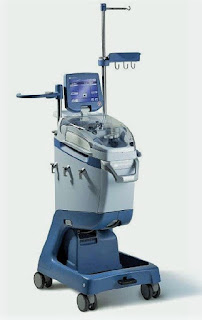Ovarian Hyperstimulation Syndrome (OHSS)
- It is a complication of some forms of fertility medication. Most cases are mild, but small proportions are severe.
Causative Medications:
- Associated with the injection of a hormone called human chorionic gonadotropin (hCG) which is used for inducing final oocyte maturation and/or triggering oocyte release.- The risk is further increased by multiple doses of hCG after ovulation and if the procedure results in pregnancy.
- Using a gonadotropin-releasing hormone (GnRH) agonist instead of hCG for inducing final oocyte maturation and/or release results in an elimination of the risk of OHSS, but a slight decrease of the delivery rate of approximately 6%.
Epidemiology:
- Sporadic OHSS is very rare and may have a genetic component.- Clomifene citrate therapy can occasionally lead to OHSS, but the vast majority of cases develop after the use of gonadotropin therapy (with the administration of FSH), (Menopur, Pergonal, Repronex) and administration of hCG to induce final oocyte maturation and/or trigger oocyte release, often in conjunction with in vitro fertilization (IVF).
- The frequency varies and depends on patient factors, management, and methods of surveillance. About 5% of treated patients may encounter moderate to severe OHSS.
- Mortality is low, but several fatal cases have been reported.
Risk Factors:
- Risk factors include young age, the development of many ovarian follicles under stimulation, extremely elevated serum estradiol concentrations, the use of hCG for final oocyte maturation and/or release, the continued use of hCG for luteal support, and the occurrence of a pregnancy (resulting in hCG production).Pathophysiology:
- OHSS has been characterized by the presence of multiple luteinized cysts within the ovaries leading to ovarian enlargement and secondary complications.- The central feature of clinically significant OHSS is the development of vascular hyperpermeability and the resulting shift of fluids into the third space.
- As hCG causes the ovary to undergo extensive luteinization, large amounts of estrogens, progesterone, and local cytokines are released. It is almost certain that vascular endothelial growth factor (VEGF) is a key substance that induces vascular hyperpermeability, making local capillaries "leaky", leading to a shift of fluids from the intravascular system to the abdominal and pleural cavity.
- Supraphysiologic production of VEGF from many follicles under the prolonged effect of hCG appears to be the specific key process underlying OHSS. Thus, while the patient accumulates fluid in the third space, primarily in the form of ascites, she actually becomes hypovolemic and is at risk for respiratory, circulatory, and renal problems. Patients who are pregnant sustain the ovarian luteinization process through the production of hCG.
- Avoiding OHSS typically requires interrupting the pathological sequence, such as avoiding the use of hCG. One alternative is to use a GnRH agonist instead of hCG.
Classification:
Mild OHSS:
- The ovaries are enlarged (5–12 cm), slight weight gain, mild abdominal distension, abdominal pain, nausea, diarrhea, and there may be an accumulation of ascites.Moderate OHSS:
- Excessive weight gain (> 2 pounds/day or > 1 kg/day), increased abdominal girth, vomiting, darker urine and oliguria, excessive thirst, and dry skin and/or hair (in addition to mild symptoms).Severe OHSS:
- Marked abdominal distention, lower abdominal pains, darker urine or anuria, pleural effusion, respiratory distress, calf and chest pains. There may be hemoconcentration, and thrombosis (in addition to mild and moderate symptoms).- Symptoms generally resolve in 1 to 2 weeks but will be more severe and persist longer if pregnancy occurs. This is due to hCG from the pregnancy acting on the corpus luteum in the ovaries in sustaining the pregnancy before the placenta has fully developed. Typically, even in severe OHSS with a developing pregnancy, the duration does not exceed the first trimester.
- Early OHSS develops before pregnancy testing and late OHSS is seen in early pregnancy.
Criteria for Severe OHSS:
- Enlarged ovary, ascites.
- Hematocrit > 45%, WBC > 15,000/microliter.
- Oliguria, creatinine 1.0-1.5 mg/dL, creatinine clearance > 50 ml/min.
- Liver dysfunction, anasarca (extreme generalized edema).
Critical OHSS:
- Enlarged ovary, tense ascites with hydrothorax and pericardial effusion.- Hematocrit > 55%, WBC > 25,000/microliter.
- Oligoanuria, creatinine > 1.6 mg/dL, creatinine clearance < 50 mL/min.
- Renal failure, thromboembolic phenomena (DVT, PE), ARDS.
Complications:
- Ovarian torsion, ovarian rupture, thrombophlebitis, and renal insufficiency.Prevention:
- Physicians can reduce the risk of OHSS by monitoring FSH therapy, and by withholding hCG medication.- Regarding dopamine agonists as prophylaxis, a systematic review and meta-analysis concluded that prophylactic treatment with Cabergoline (Dostinex) reduces the incidence, but not the severity of OHSS, without compromising pregnancy outcomes.
- OHSS may also be prevented by coasting, which is ovarian hyperstimulation in IVF without hCG administration for final maturation of follicles.
Treatment:
Mild OHSS:
- Can be treated conservatively with monitoring of abdominal girth, weight, and discomfort on an outpatient basis until either conception or menstruation occurs. Conception can cause mild OHSS to worsen in severity.Moderate OHSS:
- Is treated with bed rest, fluids (IV hydration), and close monitoring of labs such as electrolytes (hyponatremia, hyperkalemia, acidosis), blood counts, and coagulation profile (PT, aPTT, INR). Ultrasound may be used to monitor the size of ovarian follicles. Depending on the situation, a physician may closely monitor a patient's fluid intake and output on an outpatient basis, looking for an increased discrepancy in fluid balance (over 1-liter discrepancy is cause for concern). Resolution of the syndrome is measured by decreasing the size of the follicular cysts on 2 consecutive ultrasounds.Severe OHSS:
- Aspiration of accumulated fluid (ascites) from the abdominal (paracentesis) / pleural cavity may be necessary, intercostal tube, as well as opioids for the pain.- If the OHSS develops within an IVF protocol, it can be prudent to postpone the transfer of the pre-embryos since the establishment of pregnancy can lengthen the recovery time or contribute to a more severe course.

































